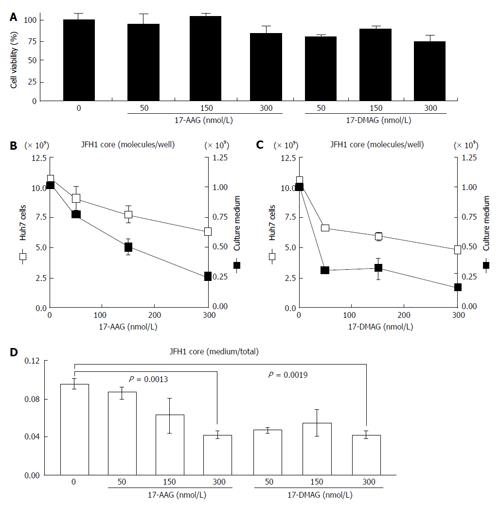Copyright
©The Author(s) 2016.
World J Hepatol. Feb 18, 2016; 8(5): 282-290
Published online Feb 18, 2016. doi: 10.4254/wjh.v8.i5.282
Published online Feb 18, 2016. doi: 10.4254/wjh.v8.i5.282
Figure 2 Effects of the geldanamycin derivatives 17-allylamino-17-demethoxygeldanamycin and 17-dimethylaminoethylamino-17-demethoxygeldanamycin on the release of JFH1.
A: The cytotoxic effects of 17-AAG and 17-DMAG on Huh-7 cells carrying JFH1/HCVcc were examined as described in the text; B and C: JFH1-infected Huh-7 cells were treated with 17-AAG (B) or 17-DMAG (C) for 24 h and then the protein samples were isolated and quantified. The levels of the HCV core present in the JFH1-infected Huh-7 cells (open squares) and the culture medium (filled squares) were examined as described in the text. The scales on the left (B and C) and right sides (B and C) indicate the scales for the HCV core in the Huh-7 cells and in the culture medium, respectively; D: The ratios of the core in the medium to the total core are shown. The concentrations of 17-AAG and 17-DMAG (0-300 nmol/L) are shown under the histograms. The data represent the mean values (± SEM) of the results from three independent experiments. HCV: Hepatitis C virus; 17-AGG: 17-allylamino-17-demethoxygeldanamycin; 17-DMAG: 17-dimethylaminoethylamino-17-demethoxygeldanamycin; HCVcc: Cell culture-derived HCV.
- Citation: Kubota N, Nomoto M, Hwang GW, Watanabe T, Kohara M, Wakita T, Naganuma A, Kuge S. Hepatitis C virus inhibitor synergism suggests multistep interactions between heat-shock protein 90 and hepatitis C virus replication. World J Hepatol 2016; 8(5): 282-290
- URL: https://www.wjgnet.com/1948-5182/full/v8/i5/282.htm
- DOI: https://dx.doi.org/10.4254/wjh.v8.i5.282









